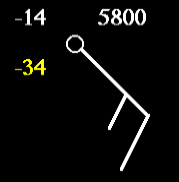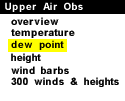
|

The value highlighted in yellow located in the lower left corner (in the diagram above) is the dew point temperature in degrees Celsius. In this example, the reported dew point temperature is 58 degrees.
Dew Point Temperature is defined as the temperature at which air would have to cool (at constant pressure and constant water vapor content) in order to reach saturation. Dew points provide insight into the amount of moisture in the air. The higher the dew point temperature, the higher the moisture content for air at a given temperature.
When the dew point temperature and air temperature are equal, the air is said to be saturated. Dew point temperature is NEVER GREATER than the air temperature. Therefore, if the air cools, moisture must be removed from the air and this is accomplished through condensation. This process results in the formation of tiny water droplets that can lead to the development of fog, frost, clouds, or even precipitation.
Other upper air observation maps may actually report dew point depression instead of dew point temperature. Dew point depression is the difference in degrees Celsius between the temperature and the dew point. In the example above the dew point depression would be 20 degrees.
![]() What to Look For in Dew Point Observations:
What to Look For in Dew Point Observations:
- Relative Humidity can be inferred from dew point values. When the air and dew point temperatures are very close, this indicates that the air has a high relative humidity. The opposite is true when there is a large difference between air and dew point temperatures, which points to air with a low relaitve humidity.

temperature |
|

Height |



